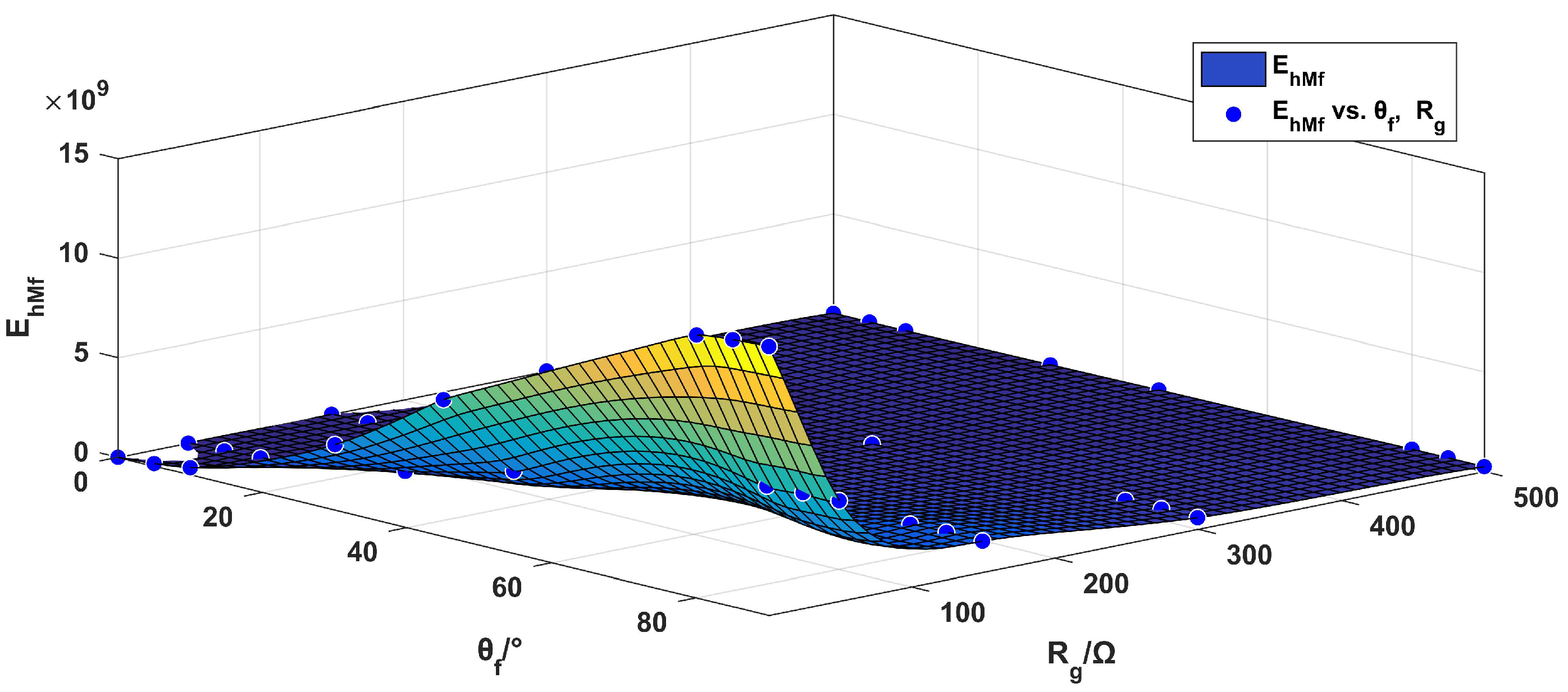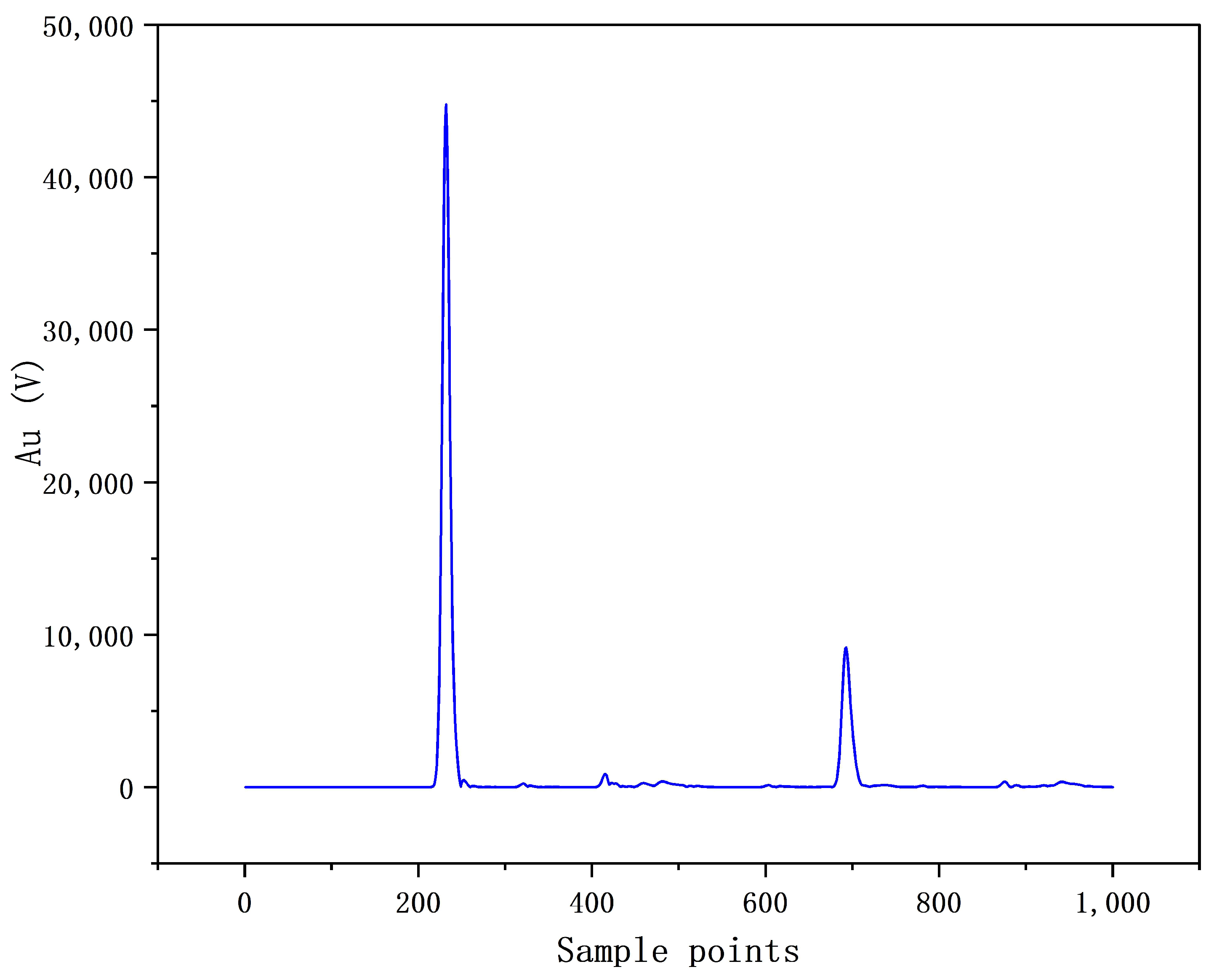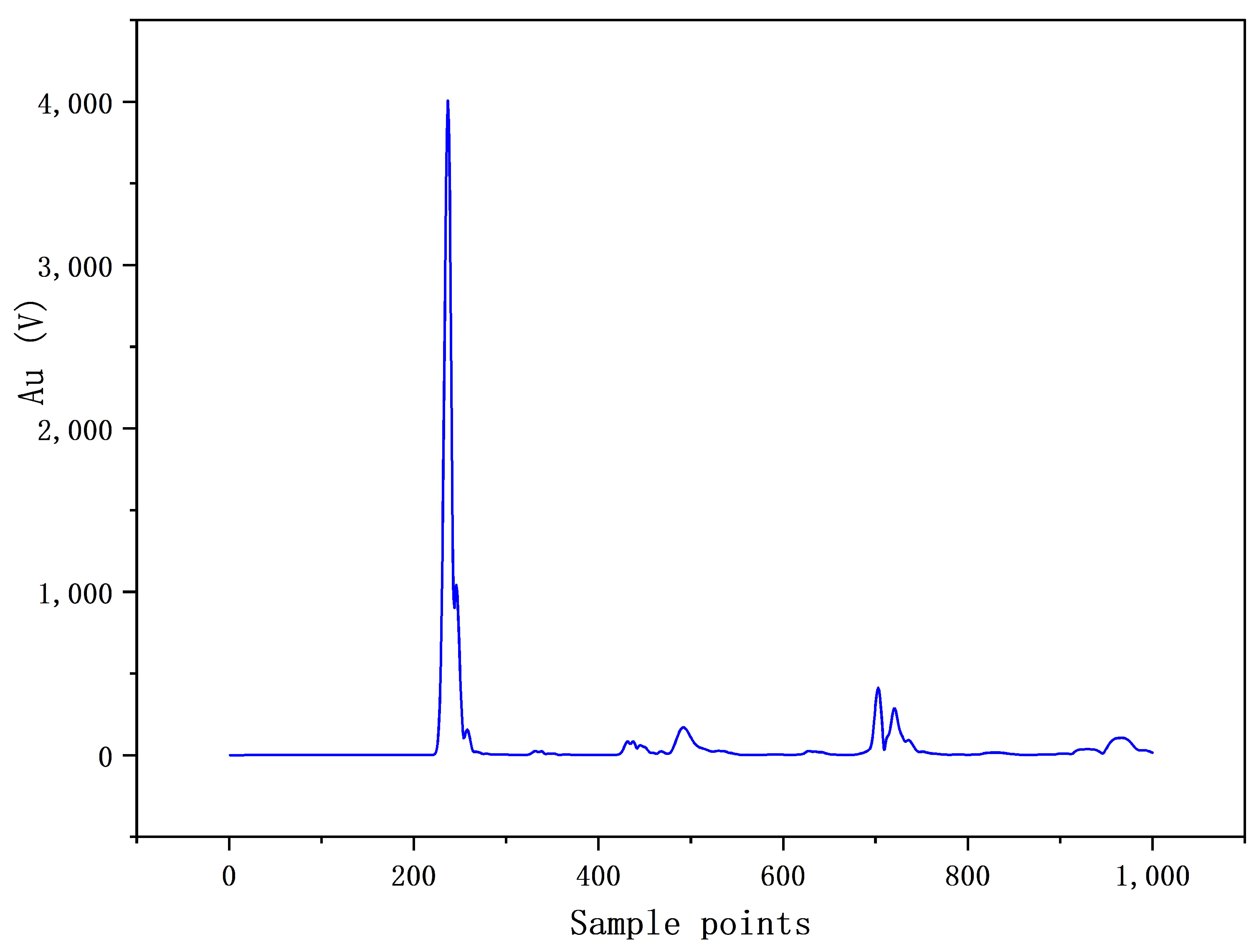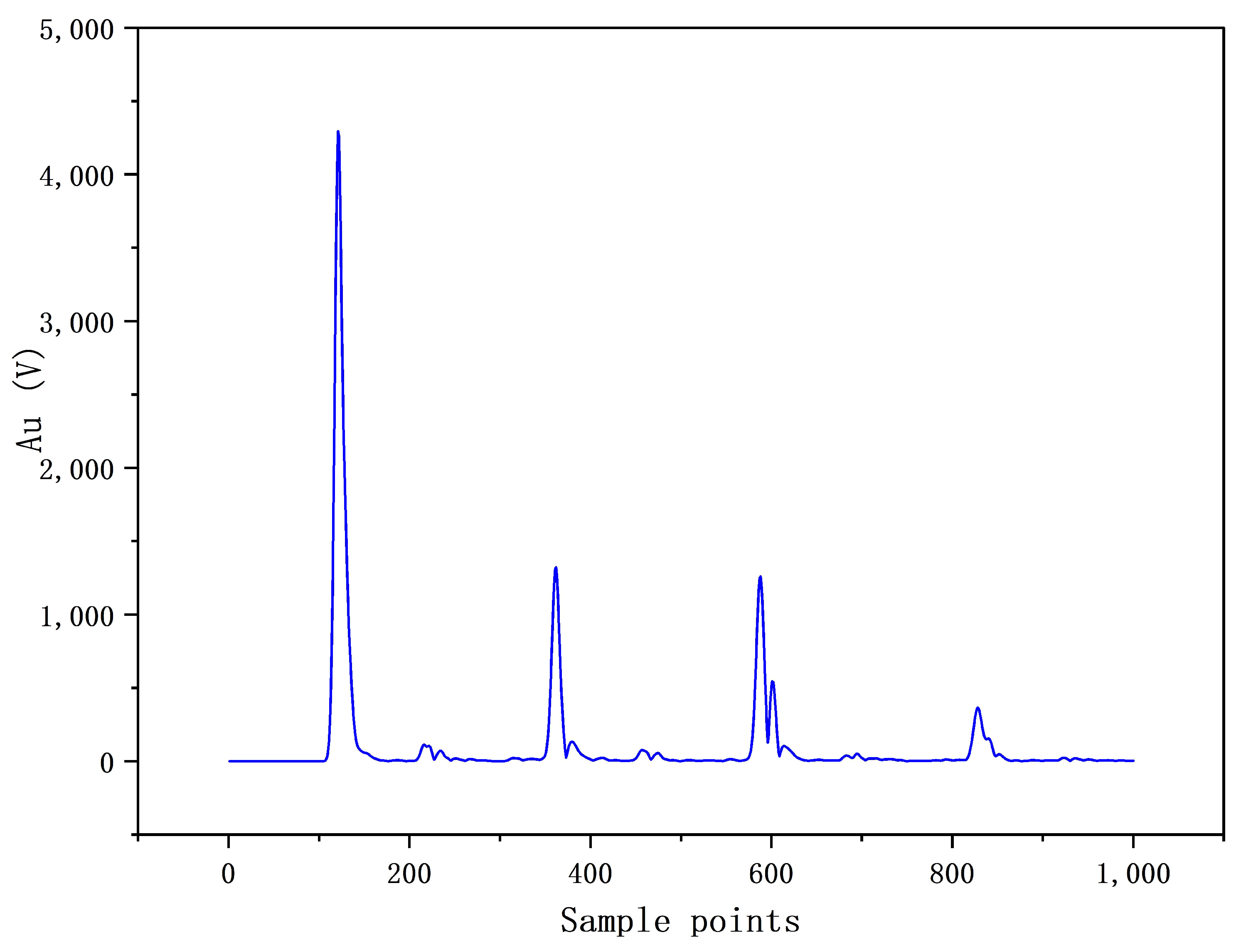Boundary Protection Based on S-Transform Considering Fault Factors
Abstract
:1. Introduction
2. Frequency Characteristics of Extra-High Voltage (EHV) Transmission Lines
3. Transmission Line Protection Based on Fault Factors
3.1. Fundamental Principle
3.2. Initial Angle
3.3. Transition Resistance
3.4. S-Transform
3.5. On the Reduction of Fault Factors
4. Simulation Example
4.1. Fault Situation in the Area
4.2. Fault Conditions Outside the Protected Line
4.3. Criterion Establishment
5. Conclusions
Author Contributions
Funding
Data Availability Statement
Conflicts of Interest
References
- Mehmed-Hamza, M.; Stanchev, P. Sensitivity and Selectivity of Time Overcurrent Relay Protection in Medium Voltage Power Lines. In Proceedings of the 2020 7th International Conference on Energy Efficiency and Agricultural Engineering (EE&AE), Ruse, Bulgaria, 12–14 November 2020; IEEE: Ruse, Bulgaria, 2020; pp. 1–4. [Google Scholar]
- Ghosh, S.; Kedarisetty, S.; Ghosh, D.; Mohanta, D.K. Failure Scenarios of Power System Protection. In Proceedings of the 2021 5th International Conference on System Reliability and Safety (ICSRS), Palermo, Italy, 24–26 November 2021; IEEE: Palermo, Italy, 2021; pp. 1–5. [Google Scholar]
- Hosseini, S.A. Analysis of Substation Protection System Failures and Reliability. In Proceedings of the 2020 15th International Conference on Protection and Automation of Power Systems (IPAPS), Shiraz, Iran, 30–31 December 2020; IEEE: Shiraz, Iran, 2020; pp. 74–79. [Google Scholar]
- Yu, D.K. A Research of Operation Stability of Overhead Transmission Lines’ Relay Protection Algorithms, Which are Based on Travelling Wave Principle. In Proceedings of the 2020 3rd International Youth Scientific and Technical Conference on Relay Protection and Automation (RPA), Moscow, Russia, 22–23 October 2020; IEEE: Moscow, Russia, 2020; pp. 1–21. [Google Scholar]
- Han, Y.; Ma, R.; Li, T.; Zeng, W.; Liu, Y.; Wang, Y.; Guo, C.; Liao, J. Fault Detection and Zonal Protection Strategy of Multi-Voltage Level DC Grid Based on Fault Traveling Wave Characteristic Extraction. Electronics 2023, 12, 1764. [Google Scholar] [CrossRef]
- Wang, S.; Xuan, X.; Wen, M.; Qi, X.; Dong, X.; Li, B. The Research and Development of the High-Speed Transmission Line Protection Based on the Transient Information. In Proceedings of the 2019 IEEE 8th International Conference on Advanced Power System Automation and Protection (APAP), Xi’an, China, 21–24 October 2019; IEEE: Xi’an, China, 2019; pp. 883–887. [Google Scholar]
- Lima, J.R.; Costa, F.B.; Lopes, F.V. Two-terminal traveling-wave-based non-homogeneous transmission-line protection. Electr. Power Syst. Res. 2023, 223, 109622. [Google Scholar] [CrossRef]
- Hu, J.; Wang, Z.; Lan, Y.; Hao, W.; Zhang, Y. Wavelet Energy Entropy-based Transient Protection for EHV AC Transmission Line. J. N. China Electr. Power Univ. (Nat. Sci. Ed.) 2019, 46, 10–18. [Google Scholar]
- Zheng, T.; Song, X. Fast Protection Scheme for AC Transmission Lines Based on Ratio of High and Low Frequency Energy of Transient Traveling Waves. Power Syst. Technol. 2022, 46, 4616–4624. [Google Scholar]
- Yang, R.; Chen, L. A New Principle of Busbar Protection Based on S-transform Current Phase Comparison. Electr. Eng. Mater. 2019, 2, 34–42. [Google Scholar]
- dos Santos, A.; de Barros, M.T.C. Comparative Analysis of Busbar Protection Architectures. IEEE Trans. Power Deliv. 2016, 31, 254–261. [Google Scholar] [CrossRef]
- Wu, H.; Dong, X.; Ye, R. A new algorithm for busbar protection based on the comparison of initial traveling wave power. IEEJ Trans. Electr. Electron. Eng. 2019, 14, 520–533. [Google Scholar] [CrossRef]
- Deng, F.; Zu, Y.; Huang, Y. Research on Single-ended Fault Location Method Based on the Dominant Frequency Component of Traveling Wave Full-waveform. Proc. CSEE 2021, 41, 2156–2167. [Google Scholar]
- Rodriguez-Herrejon, J.; Reyes-Archundia, E.; Gutierrez-Gnecchi, J.A.; Olivares-Rojas, J.; Méndez-Patiño, A. Analysis by Traveling Waves for a Protection Scheme of Transmission Lines with a UPFC. IEEE Lat. Am. Trans. 2024, 22, 46–54. [Google Scholar] [CrossRef]
- Kong, H.; Cong, W.; Zhang, H.; Qiu, J.; Chen, M.; Wei, Z. New Protection Method for High-Voltage Transmission Lines Based on Traveling Wave Energy Comparison. In Proceedings of the 2021 IEEE IAS Industrial and Commercial Power System Asia (IEEE I&CPS Asia 2021), Chengdu, China, 18–21 July 2021; IEEE: New York, NY, USA, 2021; pp. 1115–1120. [Google Scholar]
- Nayak, K.; Jena, S.; Pradhan, A.K. Travelling Wave Based Directional Relaying without Using Voltage Transients. IEEE Trans. Power Deliv. 2021, 36, 3274–3277. [Google Scholar] [CrossRef]
- Wang, H.; Li, X.; Dong, X.; Jiang, X. A Backup Protection Based on Compensated Voltage for Transmission Lines Connected to Wind Power Plants. Electronics 2024, 13, 743. [Google Scholar] [CrossRef]
- Li, X.; Ding, X.; Shu, H.; Na, A.N. A fault identification method of an AC transmission line based on a multifractal spectrum. Power Syst. Prot. Control 2021, 49, 1–10. [Google Scholar]
- Zeng, X.; Zhang, Y.; Wu, Z. HHT based non-unit transmission line protection using traveling wave. In Proceedings of the 2009 IEEE Power & Energy Society General Meeting, Calgary, AB, Canada, 26–30 July 2009; IEEE: Calgary, AB, Canada, 2009; pp. 1–5. [Google Scholar]
- Li, X.P.; He, Z.Y.; Wu, X.; Lin, S. Ultra High Speed Directional Element Based on Amplitude Comparison Using S-transform Energy Relative Entropy. Autom. Electr. Power Syst. 2014, 38, 113–117. [Google Scholar]
- Ghashghaei, S.; Akhbari, M. Transmission line fault distance and direction estimation using artificial neural network. Int. J. Eng. Sci. Technol. 2011, 3, 110–121. [Google Scholar]
- Xu, F.; Dong, X.; Wang, B.; Shi, S. Combined single-end fault location method of transmission line and its experiments. Electr. Power Autom. Equip. 2014, 34, 37–42. [Google Scholar]
- Li, Y.; Zhang, T.; Wen, A. A new location method for UHV AC transmission lines with high resistance faults based on single terminal volume. Power Syst. Prot. Control 2020, 48, 27–33. [Google Scholar] [CrossRef]
- Cong, W.; Ma, Y.; Cheng, X.; Qiu, S.; Wang, G.; Yi, G.; Zhang, L. Transition resistance calculation based on time-domain signals of two terminals. Electr. Power Autom. Equip. 2013, 33, 63–67. [Google Scholar]
- Yu, K.; Mao, Y.; Li., Y.; Zeng, X.; Xie, L. VMD-S Traveling Wave Signal Extraction Method Under Strong Noise. In Proceedings of the 2018 China International Conference on Electricity Distribution (CICED), Tianjin, China, 17–19 September 2018; IEEE: Tianjin, China, 2018; pp. 1739–1743. [Google Scholar]









| 1 | 50 | 150 | 300 | 500 | |
|---|---|---|---|---|---|
| Internal faults (4 km away from M) | |||||
| 0 | 11.4000 | 4.28500 | 1.34400 | 0.48960 | 0.20980 |
| 2 | 258.000 | 96.5500 | 30.2800 | 11.0300 | 4.72600 |
| 5 | 1269.00 | 475.000 | 147.900 | 63.8300 | 27.3500 |
| 10 | 3581.00 | 1339.00 | 418.600 | 152.100 | 65.1000 |
| 30 | 32,800.0 | 12,270.0 | 3835.00 | 1393.00 | 596.400 |
| 45 | 6872.00 | 25,710.0 | 8036.00 | 2920.00 | 1250.00 |
| 80 | 131,200 | 49,100.0 | 15,340.0 | 5574.00 | 2386.00 |
| 85 | 134,100 | 50,180.0 | 15,680.0 | 5700.00 | 2440.00 |
| 90 | 135,000 | 50,480.0 | 15,700.0 | 5735.00 | 2454.00 |
| External faults (4 km away from N) | |||||
| 0 | 0.66920 | 0.34970 | 0.14480 | 0.06169 | 0.02884 |
| 2 | 10.1000 | 5.30500 | 2.19700 | 0.93600 | 0.43760 |
| 5 | 46.7400 | 24.4600 | 10.1300 | 4.31600 | 2.01800 |
| 10 | 120.800 | 63.3400 | 26.3000 | 11.2000 | 5.23600 |
| 30 | 1132.00 | 593.000 | 246.500 | 105.100 | 49.1000 |
| 45 | 2408.00 | 1266.00 | 523.000 | 223.500 | 104.600 |
| 80 | 4579.00 | 2397.00 | 994.900 | 424.000 | 198.100 |
| 85 | 4677.00 | 2454.00 | 1019.00 | 434.100 | 201.900 |
| 90 | 4704.00 | 2468.00 | 1020.00 | 436.300 | 204.000 |
| 1 | 50 | 150 | 300 | 500 | |
|---|---|---|---|---|---|
| 0 | 0.810 | 0.950 | 1.010 | 1.194 | 1.252 |
| 5 | 0.500 | 0.611 | 0.708 | 0.781 | 0.826 |
| 10 | 0.492 | 0.580 | 0.671 | 0.732 | 0.769 |
| 30 | 0.485 | 0.571 | 0.662 | 0.721 | 0.757 |
| 45 | 0.481 | 0.566 | 0.656 | 0.715 | 0.751 |
| 80 | 0.478 | 0.564 | 0.655 | 0.714 | 0.751 |
| 85 | 0.478 | 0.563 | 0.652 | 0.712 | 0.747 |
| 90 | 0.478 | 0.563 | 0.655 | 0.711 | 0.747 |
| 1 | 50 | 100 | 300 | 500 | |
|---|---|---|---|---|---|
| 4 km from N terminal | |||||
| 0 | 0.0059 | 0.0081 | 0.0107 | 0.0126 | 0.0137 |
| 5 | 0.0037 | 0.0062 | 0.0071 | 0.0083 | 0.0090 |
| 10 | 0.0036 | 0.0050 | 0.0067 | 0.0078 | 0.0085 |
| 30 | 0.0036 | 0.0050 | 0.0067 | 0.0078 | 0.0085 |
| 45 | 0.0035 | 0.0049 | 0.0065 | 0.0076 | 0.0084 |
| 80 | 0.0035 | 0.0049 | 0.0065 | 0.0076 | 0.0083 |
| 85 | 0.0035 | 0.0049 | 0.0065 | 0.0076 | 0.0083 |
| 90 | 0.0035 | 0.0049 | 0.0065 | 0.0076 | 0.0083 |
| 166 km from N terminal | |||||
| 0 | 0.00007 | 0.0001 | 0.0001 | 0.0002 | 0.0002 |
| 5 | 0.0025 | 0.0037 | 0.0050 | 0.0059 | 0.0066 |
| 10 | 0.0028 | 0.0042 | 0.0058 | 0.0069 | 0.0076 |
| 30 | 0.0030 | 0.0044 | 0.0060 | 0.0071 | 0.0079 |
| 45 | 0.0031 | 0.0046 | 0.0063 | 0.0075 | 0.0083 |
| 80 | 0.0031 | 0.0047 | 0.0064 | 0.0076 | 0.0084 |
| 85 | 0.0031 | 0.0047 | 0.0064 | 0.0077 | 0.0084 |
| 90 | 0.0031 | 0.0047 | 0.0064 | 0.0077 | 0.0084 |
| 1 | 50 | 100 | 300 | 500 | |
|---|---|---|---|---|---|
| 4 km from M terminal | |||||
| 0 | 0.0042 | 0.0058 | 0.0073 | 0.0084 | 0.0091 |
| 5 | 0.0042 | 0.0058 | 0.0074 | 0.0086 | 0.0093 |
| 10 | 0.0043 | 0.0058 | 0.0075 | 0.0087 | 0.0094 |
| 30 | 0.0043 | 0.0058 | 0.0075 | 0.0087 | 0.0095 |
| 45 | 0.0043 | 0.0058 | 0.0075 | 0.0087 | 0.0096 |
| 80 | 0.0043 | 0.0058 | 0.0075 | 0.0087 | 0.0096 |
| 85 | 0.0043 | 0.0058 | 0.0075 | 0.0087 | 0.0096 |
| 90 | 0.0043 | 0.0058 | 0.0073 | 0.0087 | 0.0095 |
| 176 km from M terminal | |||||
| 0 | 0.0003 | 0.0005 | 0.0006 | 0.0008 | 0.0008 |
| 5 | 0.0052 | 0.0073 | 0.0101 | 0.0119 | 0.0131 |
| 10 | 0.0057 | 0.0082 | 0.0111 | 0.0130 | 0.0142 |
| 30 | 0.0059 | 0.0084 | 0.0115 | 0.0136 | 0.0148 |
| 45 | 0.0061 | 0.0086 | 0.0118 | 0.0139 | 0.0152 |
| 80 | 0.0057 | 0.0082 | 0.0111 | 0.0130 | 0.0142 |
| 85 | 0.0048 | 0.0072 | 0.0099 | 0.0118 | 0.0130 |
| 90 | 0.0048 | 0.0072 | 0.0100 | 0.0118 | 0.0130 |
Disclaimer/Publisher’s Note: The statements, opinions and data contained in all publications are solely those of the individual author(s) and contributor(s) and not of MDPI and/or the editor(s). MDPI and/or the editor(s) disclaim responsibility for any injury to people or property resulting from any ideas, methods, instructions or products referred to in the content. |
© 2024 by the authors. Licensee MDPI, Basel, Switzerland. This article is an open access article distributed under the terms and conditions of the Creative Commons Attribution (CC BY) license (https://creativecommons.org/licenses/by/4.0/).
Share and Cite
Guo, Z.; Huang, J.; Deng, Y.; Huang, Q.; Luo, Y.; Huang, Z. Boundary Protection Based on S-Transform Considering Fault Factors. Electronics 2024, 13, 1464. https://doi.org/10.3390/electronics13081464
Guo Z, Huang J, Deng Y, Huang Q, Luo Y, Huang Z. Boundary Protection Based on S-Transform Considering Fault Factors. Electronics. 2024; 13(8):1464. https://doi.org/10.3390/electronics13081464
Chicago/Turabian StyleGuo, Zhenwei, Jiemei Huang, Yingcai Deng, Qian Huang, Yi Luo, and Zebo Huang. 2024. "Boundary Protection Based on S-Transform Considering Fault Factors" Electronics 13, no. 8: 1464. https://doi.org/10.3390/electronics13081464






